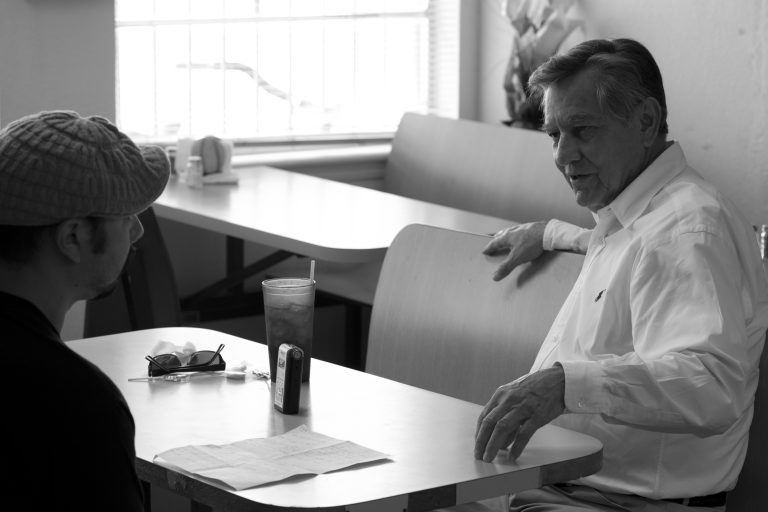“Far beyond an assortment of communities, the border is an area with an intangible ambiance nearly impossible to capture in picture or words. It is history, tradition, family and acceptance with a flavor which is unique. It is two everlasting languages, both written and spoken; menus, billboards, traffic signs, radio and television stations cross as do church services, newspapers, households and music. The border is a singularly beautiful area that has a mystique, a soul, a spirit all its own. It is America, it is Mexico, with its hardships and joys, successes and failures, the border embraces you. It is home.” —Nestor Valencia
Nestor Valencia is a native El Pasoan born and raised in Ysleta. After serving four years in the U.S. Air Force Nestor went on to earn a BA in Art and a Master’s Degree in Political Science. He began working for the city of El Paso in 1958 and ended his career as Director of Planning in 1991. Seeking a new outlet, Nestor became a professor and taught at the University of Texas El Paso for 12 years. During that time he also worked for the El Paso Community Foundation as Vice President from 1991 through 2008. Nestor has 54 years of service in the community. His involvement in city projects include: The Chamizal Settlement, Wyler Aerial Tramway, and the Plaza Theatre. One major accomplishment he was a proponent of was the defeat of the proposed Sierra Blanca nuclear waste dump site. As a representative for El Paso and Ciudad Juarez, he wrote a position paper against the dump site and spent countless hours testifying on behalf of both communities until the proposal was overcome. His love for the border community is beyond measure. Nestor Valencia is a true border hero! Fusion Mag sat down with Nestor to ask him a few questions about a time when trolleys roamed across the desert floor.
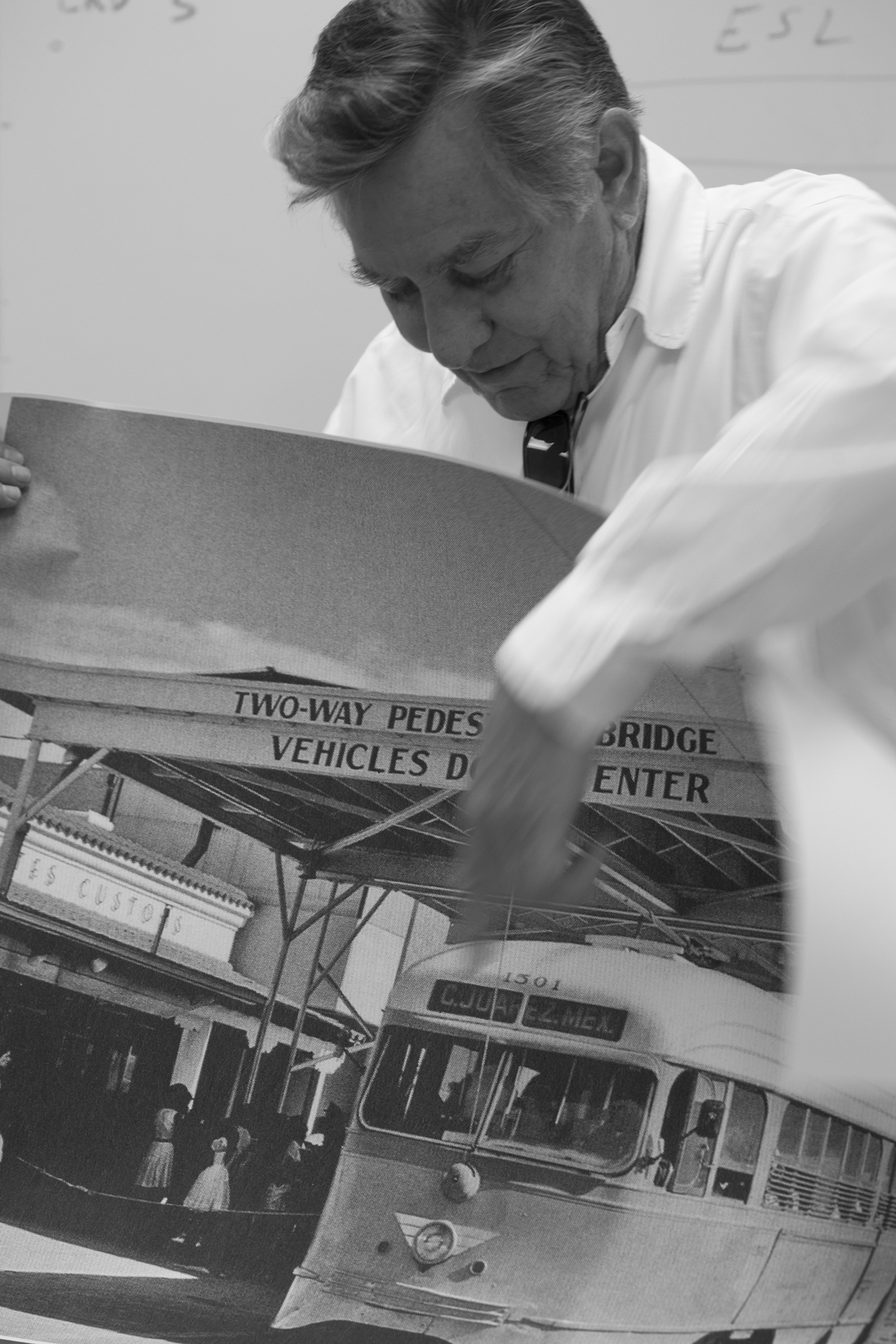
What is your relationship to the trollies that ran from 1882 to 1974?
I have always been fascinated with street cars. My mother and I used to travel to Juarez every weekend to go shop and that sort of thing for years. In 1973, after I became executive assistant to Mayor Fred Hervey, the Juarez and the Mexican government stopped the service between the two countries. At which time, the mayor asked me to practically get full time in the business of street cars. He asked me to negotiate the street cars– to buy the property, to buy the lines, to buy all the equipment, all of the rolling stock and I negotiated both of them but everything that was on the streets and off the streets. We bought the whole system including the system in Juarez with the idea that we were going to put it back to work. We went many times to Mexico City to negotiate the re-establishment of the line. Unfortunately, we went through the Fred Hervey period, we went through a Don Henderson period, which was the next mayor. We had four years of non-stop battle to get them running. I think we had, in today’s money, 200 million dollars worth of everything and unfortunately the mayor that succeeded Don Henderson pretty much killed the system at the time we were going to make it run again. That was a big defeat; that was a big disappointment in my life. I was put in charge of making the street cars run again and we were making terrific progress towards the end with Mexico, with the minister of transportation, and many other officials, but it died. Had that not happened, we would have a street car system in El Paso functioning right now.
Why did Mexico stop the Trolley services to El Paso?
There are two reasons. One is a two sided deal. Mexico did not want the continuation of Mexican customers to come and buy in El Paso. They would come over and we were pretty cheap. They would buy goods and then return back in the street cars. Juarez wanted to become competitive and the Chamber of Commerce was one of the organizations in Juarez that wanted to stop it. They pretty much did. The other part is the Mexican toll collectors at the bridge. Both bridges were owned by the same company and the Mexican government controlled the amount of money you could collect at the bridge. The company was paying more for the employees than they were getting; a lot more money to keep the toll collectors there than they were receiving. It got to a point that it was impractical. So, the Chicago based company felt that it was time to go away. They sold us the street cars. They didn’t have to deal with the Mexican based government because the Chicago based company knew they were not going to get anywhere with Mexico.
Who was responsible for bringing the Trolley to El Paso and Ciudad Juarez?
It was a private corporation that started with Mandy the Mule and it was a one wagon street car. It began in 1882 with one coach, one tiny little wagon, maybe 10-12 passengers and one mule and one driver. I don’t recall the names of the people but I have in my home the documentation of who they were and how they set it up.
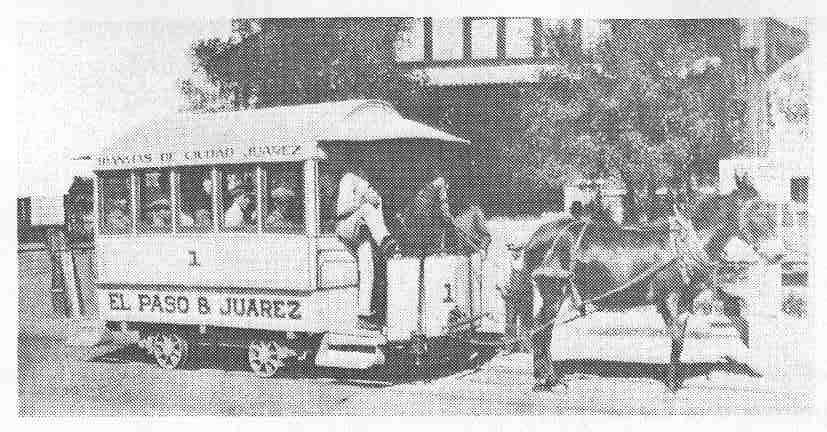 So, the trolley belonged to the private corporation?
So, the trolley belonged to the private corporation?
The trolley system was always privately owned. The city didn’t have a say so in it.
At the climax of the Trolley system, what was the relationship like between the Ciudad Juarez and El Paso?
There are certain periods in the process right after the war of 1848, 1850, and 1860, there was a lot of animosity between the two countries. It was very difficult to be a Mexican-American on now American soil. There was a good amount of discrimination. It became a two party city, them and us. The city was pretty much divided.
Where did it run through?
It covered everything from downtown to the cantonment, the army, towards Dyer, all of Kern Place, all of the center, central park all the way to Thomason General Hospital to Clardy Fox. We had 26 miles of Trolley, including one line all the way to Ysleta. It was an incredible network of street cars. In Juarez, it went all the way to the racetrack. There was gambling in Juarez and the company put a very interesting line all the way to the Juarez racetrack, which was way down south of Juarez, and here were these guys that were going to go gamble, they were in nice looking suits, hats and shined shoes; they would get off the street car and go gamble and get back on the street car and it would bring them back to El Paso.

 How many people would ride the trolley on a daily basis?
How many people would ride the trolley on a daily basis?
The last count that I had, we moved about 6 million people year round.
How efficient was the trolley system?
It was very efficient! It was an electric wagon system, electric motor. It was pollution free. We had the best of the equipment PCC 39’s and they were in top shape.
Can you tell me a little about the PCC 39’s?
From 1860’s and 1870’s, around the world, especially Mexico City, had a street car system. Europe, London, Germany, you can go on and on. Street cars were universal in the world and they had different models from the Mules to the first electric cars that came into El Paso about 1892, tiny little wagons. Then, we had square models and we had very antique kind-of-like little houses that moved. Then, we went to a more sophisticated wagon which was kind of like a double decked with a roof on it. That went all the way to 1939 when the presidential coach commission of street cars came into being to design the street cars that you now see. They made them look modern. That was the era when America and the world were looking at to make things slick and modern. It was the modernization of trains, street cars, and even cars got that slick look. The beauty of it is that its survived time. If you look at it now, it’s attractive. The sadness of it is that the city owned 19 of them in top condition. When we bought them they had just been rewound and a street car has nothing but wheels and a motor. There is nothing that can go wrong with it. There are no mechanical parts, just a motor. You rewind the motor and you’re good for another 20 years. We had the most beautiful shop where they would get fixed with state of the art equipment.
Can you tell me a little about the trolley conductors?
Well, if you were a child of 5, 6, 8 years old they were your heroes because they could drive a street car. If you had a chance to go on a street car the best thing you can do is go behind him or next to him and see him operate the street cars. They operated either way. There was no front or back. The guy would go from the front of the street car, go to the back, same operation, same seat, same everything. He just had to get out and change the cord from this side to the other side. They were heroes that could drive a street car.
What are the steps it would take to bring back an international street car?
The first thing you get is a guaranteed agreement with Mexico. Short of that, don’t even think it. Without a permit that allows you to cross the border to provide service in Juarez strong enough to bridge administrations both federal, state and local, you don’t have anything. It’s just wishful thinking unless you have that agreement signed, sealed and guaranteed.
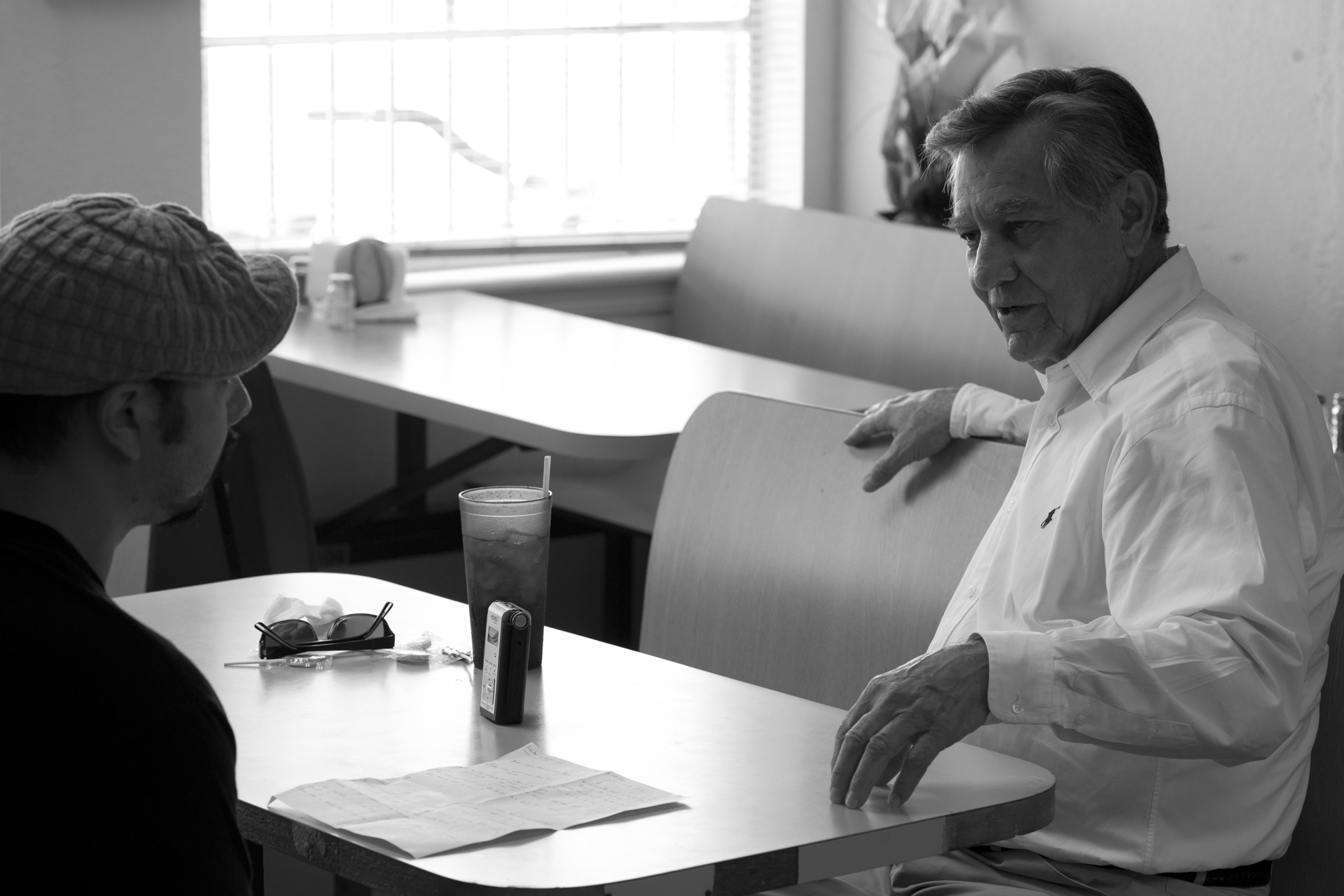
Say you have that…
I think you need investors on both sides that see the enterprising potential of putting the street car system into operation. That it is profitable to merchants, business, tourism and you develop a bi-national company that takes care of it. It can be a municipal government; it can be a private enterprise. You’re looking at possibly 20 million dollars to put the loop back into operation.
Would new track have to be purchased? Can the track at the airport be used? Can the PCC’s be salvaged?
If you have enough interest, those can be restored. They’re not going to be exactly the originals but they’re workable. The carriage is good, the motor is good, the whole system is good, you just cosmetically have to improve it back to what it was. The big deal is laying the rail. That is going to be expensive, which we already had in place.
Realistically, how close is it to coming back?
If you’re ever going to have anything bi-national/international, it’s going to have to be a rapid train system or a monorail. I don’t think, at this point, you are going to bring back the street cars, now or the next 50 years. You can bring up the idea of a monorail system that is really fast and modern to serve 2.5 million people and strategically land it where you can make money on both sides and take that monorail and wrap it around both cities to make this whole system monorail serviced, El Paso and Juarez.

Where there any plans for any other systems or a monorail system?
Absolutely, as a matter of fact, one of the agreements we had with Mexico in the end when we had the permit was that with the street car service there were then two or three years we would put in a monorail system as well. Mexico wanted the monorail…kind of, we wanted the street cars and they preferred the monorail. We had the plans to do both; beautiful plans and beautiful systems.
There are 16 street cars left at the airport? Is that right?
We bought 19. Out of those 19 I can only account for about 9. What’s happened to the rest, you hear rumors that they were sold, that they were melted. Unfortunately, I don’t know if you’ve seen the pictures, they’re awfully terrible, horrible condition. They’re just like skeletons dying in the desert.
If you had the ability to do something with those cars, what would you do?
Well, the ideal system would be to run them for a mile or two somewhere in the city, like New Orleans street car named “Desire.” Short of that, the only thing you can do with those wagons before they disappear is make them into restaurants. Put them all over the city. Make it a chain, make it an entrepreneurship. There is precedence to the idea of the diner, but we have more reason to put it in there than just a mom and pop operation. This is tradition and history that should not be buried.
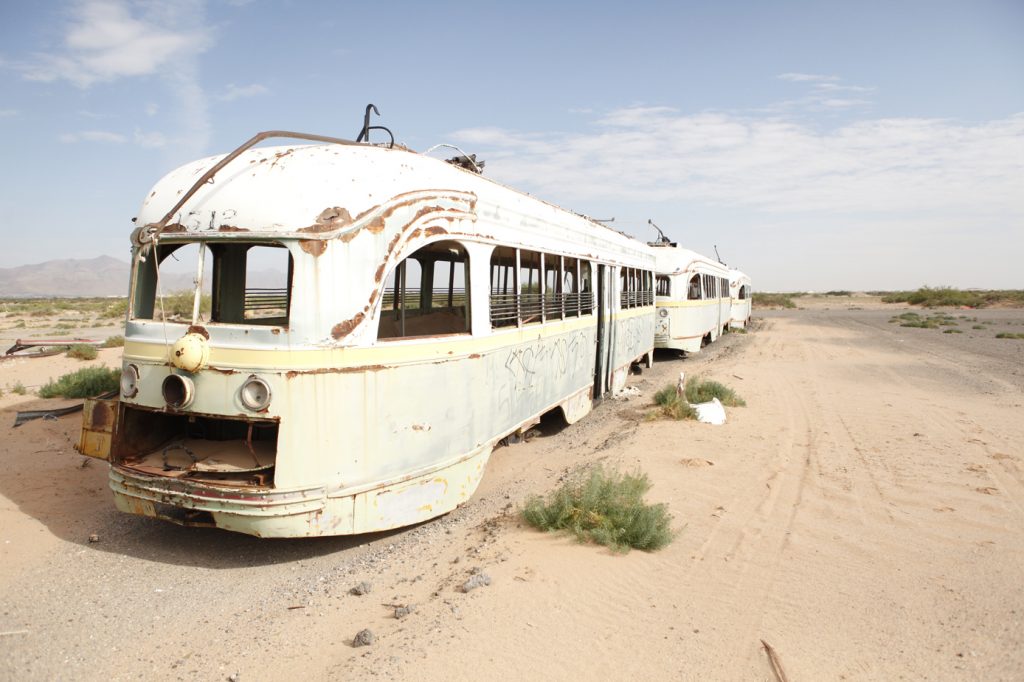 VIDEO: RON DAWSON
VIDEO: RON DAWSON
PHOTOS: PETER SVARZBEIN (C) 2011
www.mongovision.com


